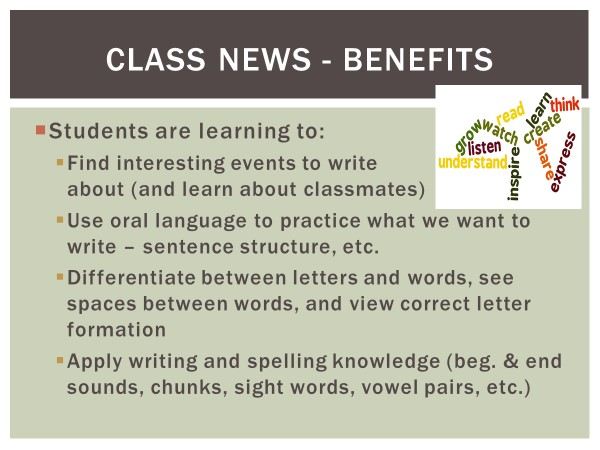by C. Elkins, OK Math and Reading Lady
I will share several writing strategies via this series of posts on Writing. Part 1 was a focus on the continuum and word-writing strategies. Part 2 focused on the importance of letter formation and handwriting (printing) with a way to incorporate it with concepts of print, phonics, and composing sentences. In this part, I would like to focus on a modeling / shared writing strategy I call “Class News.” I utilized this strategy with KG-3rd grade classes and will share some pictures and ideas with you. I also wrote an article about this that appeared many years ago in the Oklahoma Reader, a publication by the OK Reading Association.

What is it? I called students together each day for math talk time. After this, we held a class news session. Writing the date was part of the routine (but it doesn’t have to be). Students took turns sharing news of importance to them – and sometimes some other news about the day was added. For younger students it was a definite time to emphasize a variety of concepts of print:
- Directionality and return sweep (going to the next line from left to right)
- Spacing within and between words (see part 2 reference to “spaghetti and meatballs”)
- Letter formation – tall letters vs. short letters vs. below the line letters
- Use of capitals and punctuation
- Noticing the difference between letters, words, and sentences
- The opportunity to think aloud about letter sounds and sight words
After a sentence was orally agreed on, I wrote parts of it and solicited help from students for parts I felt they could be successful with. This often varied depending on what I wanted to emphasize. At first it was beginning letters or ending letters. Then I would try leaving out the vowels for students to work on. Gradually, different word parts or whole words were left for students to complete (usually with a different colored marker). All the while I was right next to them guiding them.
I also kept a few learning aids handy (alphabet chart with pictures, letter formation chart, vowel pairs chart, etc.) so we could reference them when needed. I have linked some FREE mini charts at the end of this post. Example: A student is finishing the word “toad” and is thinking of the correct vowel pair, so I show my vowel pairs chart and point to the word “boat” and say, “Do you see a word / picture that has the same middle sound as the word toad?” . . . child finds boat to see the letters oa. I also kept a small white board (or clip board) handy. For example, if the child came to write the sight word “have” on the chart, I might ask them to write it on the white board or clipboard first to check their thinking – that way all the kinks were worked out and the news chart stayed in a non-smudged condition. I also used the whiteboard to make sound boxes for a student to work out the sounds (like for a cvc word). Continue reading